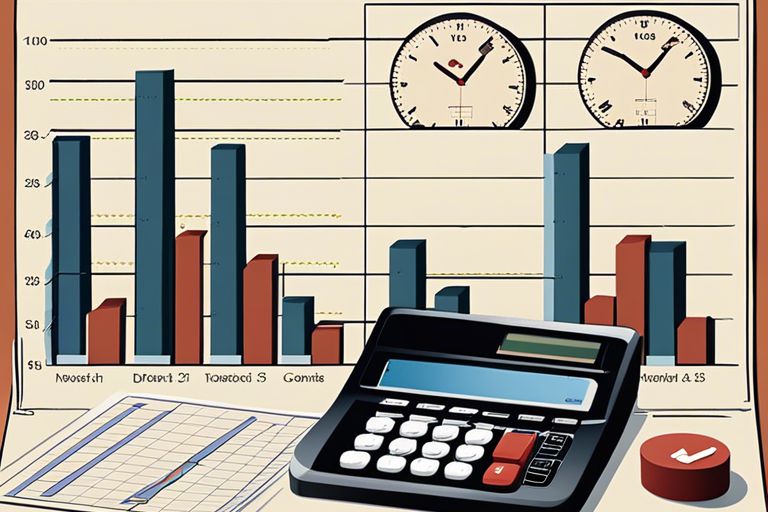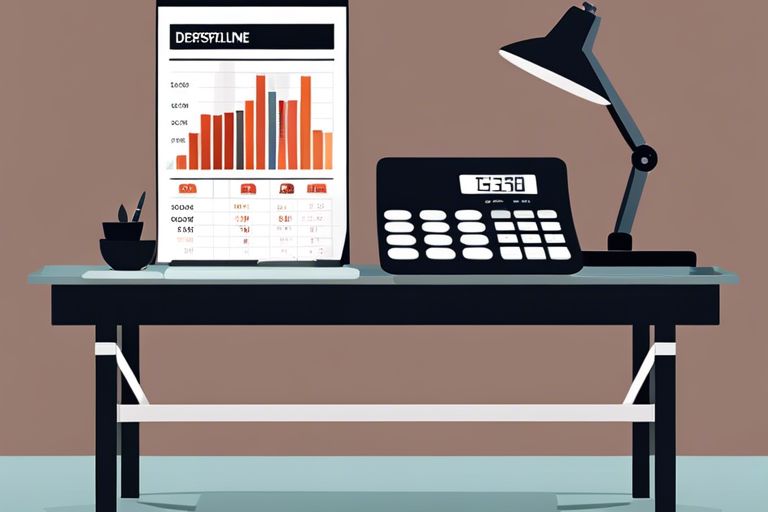Pros and Cons of Straight-Line Depreciation for Businesses
Do you understand the intricacies of straight-line depreciation for your business? Depreciation is a significant aspect of accounting, and it’s important to weigh the advantages and disadvantages of using the straight-line method. This depreciation method is widely used by businesses, as it provides a simple and predictable way to allocate the cost of an asset over its useful life.
One of the benefits of straight-line depreciation is its ease of use. You simply divide the asset’s cost minus salvage value by its useful life, and you have your annual depreciation expense. However, this method may not accurately reflect an asset’s actual decline in value over time. Additionally, it can result in higher expenses in the earlier years of an asset’s life, which can negatively impact your company’s profitability. It’s important to carefully consider whether straight-line depreciation is the best option for your business.
Key Takeaways:
- Consistency: Straight-line depreciation provides a consistent method for allocating the cost of an asset over its useful life, making it easier for businesses to plan and budget for future expenses.
- Simple Calculation: This method is straightforward and easy to calculate, making it accessible for small businesses or those without complex accounting systems.
- Reduces Profitability: While providing consistency, straight-line depreciation can also reduce reported profitability in the early years of an asset’s life, as a larger portion of the cost is expensed upfront.
- Doesn’t Reflect Market Changes: This method does not account for the potential fluctuation in market value, meaning the asset’s book value may not reflect its true worth over time.
- May Not Match Economic Reality: As assets often do not lose value evenly over time, straight-line depreciation may not accurately reflect the economic reality of an asset’s decline in value.

Fundamentals of Straight-Line Depreciation
The concept of straight-line depreciation is based on the idea that assets lose value evenly over time. The formula for straight-line depreciation is simple: (Cost of Asset – Residual Value) / Useful Life of Asset. This method is widely used by businesses to allocate the cost of an asset evenly over its useful life.
Calculating Straight-Line Depreciation
The calculation of straight-line depreciation is straightforward. You simply subtract the residual value of the asset from its initial cost and then divide that amount by the asset’s useful life. This gives you the amount of depreciation expense to be recorded each year. For example, if a piece of machinery costs $10,000, has a residual value of $2,000, and a useful life of 5 years, the annual depreciation expense would be $1,600 ($10,000 – $2,000 / 5).
Comparison with Other Depreciation Methods
When comparing straight-line depreciation with other methods such as accelerated depreciation or double-declining balance, it’s important to consider the advantages and disadvantages of each. Straight-line depreciation is a simple and easy-to-understand method, making it attractive for small businesses with limited resources. It also provides a consistent expense over time, which can help in budgeting and forecasting. However, it may not accurately reflect the actual wear and tear of an asset, especially if it is more heavily used in the early years. This can result in higher maintenance costs later on.
| Pros | Cons |
| Simple and easy to understand | May not accurately reflect wear and tear |
| Consistent expense over time | Higher maintenance costs later on |
By using straight-line depreciation, you can easily determine the annual depreciation expense for an asset, making budgeting and forecasting simpler. However, it’s important to consider whether this method accurately reflects the actual decline in the value of the asset over time.
In the next section, we will delve into the impact of straight-line depreciation on your financial statements and how it affects your bottom line.
Pros of Straight-Line Depreciation
Assuming you are considering the use of straight-line depreciation for your business, it’s important to weigh the advantages and disadvantages. According to Advantages & Disadvantages of Straight-Line Depreciation, there are several key benefits to using straight-line depreciation for your business.
Simplicity and Ease of Use
One of the primary advantages of straight-line depreciation is its simplicity and ease of use. With this method, you can easily calculate annual depreciation expenses by dividing the cost of an asset by its useful life. This straightforward calculation makes it simple for you to forecast and track depreciation over time.
Predictability of Expense
Another benefit of straight-line depreciation is the predictability it offers in terms of expense management. By evenly spreading out the depreciation expense over the useful life of an asset, you can anticipate and budget for the future impact on your company’s financial statements. This can help you make informed decisions and plan for the long-term financial health of your business.
Financial Planning and Budgeting
Straight-line depreciation also provides a stable foundation for financial planning and budgeting. When you use this method, you can accurately forecast your future expenses and allocate resources accordingly. This can help you make strategic business decisions and ensure that your company’s financial resources are being used effectively and efficiently.
Tax Implications
Finally, straight-line depreciation can have positive tax implications for your business. By evenly spreading out the depreciation expense over the useful life of an asset, you can potentially reduce your taxable income each year, leading to lower tax obligations. This can help you maximize your cash flow and minimize your tax burden, ultimately benefiting your bottom line.
As you can see, there are several compelling reasons to consider using straight-line depreciation for your business. From its simplicity and predictability to its impact on financial planning and tax implications, this method offers significant advantages that can positively impact your company’s financial health.
Cons of Straight-Line Depreciation
To fully understand the drawbacks of straight-line depreciation, it’s important to delve deeper into some of its key limitations. Let’s explore some of the most significant reasons why this method may not be the best fit for your business.
Asset Usage Pattern Mismatch
One of the main downsides of straight-line depreciation is that it assumes that an asset’s usefulness declines evenly over time. However, in many cases, this might not accurately reflect the true usage pattern of the asset. For example, technology assets such as computers or machinery might experience a front-loaded usage pattern, with the majority of wear and tear occurring in the early years, followed by a more stable period. This can lead to inaccuracies in your financial reporting, as the depreciation charges may not align with the actual wear and tear on the asset. You can learn more about this issue in our article on What is straight line depreciation?
Impact on Profitability Reporting
When using straight-line depreciation, the consistent nature of the depreciation charges can distort your financial reports. This may not accurately reflect the true profitability of your business, especially if you’re relying on those reports to make important decisions. Long-term assets may yield varying levels of value over their useful lives, and using straight-line depreciation fails to consider this. It’s important to be aware of how this depreciation method can potentially misrepresent your business’s financial health and performance. This can result in misguided investment decisions or reporting to stakeholders. It’s crucial to have a clear understanding of how this might impact your business.
No Consideration for Technological Obsolescence
In today’s rapidly evolving technological landscape, many assets become obsolete far sooner than their expected useful life under straight-line depreciation. This is particularly true for businesses that heavily rely on technology or equipment that quickly becomes outdated. As a result, you could find yourself with a significant gap between the book value of the asset and its actual market value, leading to potential losses when it’s time to replace or sell the asset. It’s essential to consider whether this method takes into account the real-world depreciation of your assets, particularly in industries with high technological turnover. This can have a substantial impact on your business’s financial standing and decision-making processes.
Tax Deduction Limitations
While straight-line depreciation is simple and straightforward, it may not always provide the most tax advantages for your business. This method evenly spreads out the depreciation expense over the useful life of the asset, which can limit the tax benefits you could receive from accelerated methods such as MACRS (Modified Accelerated Cost Recovery System). MACRS allows for larger depreciation deductions in the earlier years of an asset’s life, which can significantly reduce your taxable income during those periods. Depending on your business’s tax situation, it’s essential to weigh the potential benefits and limitations of this depreciation method in maximizing your tax advantages.
As you evaluate the suitability of straight-line depreciation for your business, it’s crucial to consider the potential drawbacks and how they may impact your financial reporting, taxation, and overall decision-making. Making an informed choice will lead to more accurate financial statements and a better understanding of your business’s true profitability and asset values.
The Role of Straight-Line Depreciation in Financial Statements
After acquiring an asset for your business, it is imperative to account for its gradual loss of value over time. This is where straight-line depreciation comes into play. Straight-line depreciation is an essential component of your business’s financial statements, as it allows you to accurately reflect the true value of your assets and their impact on your overall financial health.
Effect on Balance Sheet
When it comes to the balance sheet, straight-line depreciation is crucial in accurately representing the value of your assets. By spreading the cost of an asset evenly over its useful life, straight-line depreciation ensures that your balance sheet reflects the decrease in the asset’s value over time. This provides a more accurate picture of your business’s financial position and helps you make informed decisions about asset management and investment.
Influence on Income Statement
On the income statement, straight-line depreciation impacts your business by allocating a portion of the asset’s cost as an expense each year. This reduces your taxable income, providing a tax benefit that positively affects your bottom line. The consistent and predictable nature of straight-line depreciation also allows for easier comparison of financial performance over multiple periods, aiding in the assessment of your business’s long-term financial health.
Implications for Cash Flow Analysis
When it comes to cash flow analysis, straight-line depreciation affects your business by reducing your net income and, consequently, your taxes. However, it’s important to keep in mind that this is a non-cash expense. While cash isn’t actually leaving your business, it is crucial to consider the impact of straight-line depreciation on your cash flow and make adjustments as necessary to ensure your business’s ongoing financial stability.
Incorporating straight-line depreciation into your financial statements is a critical aspect of responsible asset management and financial planning for your business. It allows you to accurately depict the value of your assets over time, impacting your balance sheet, income statement, and cash flow analysis. The consistent and predictable nature of straight-line depreciation aids in making informed decisions and ensures the accuracy and reliability of your financial statements.

Straight-Line Depreciation and Asset Management
Your choice of depreciation method can have a significant impact on your asset management strategy. When using the straight-line method, you allocate the same amount of depreciation expense to each year of an asset’s useful life. This can offer several advantages and disadvantages in terms of long-term asset planning and residual value considerations.
Long-term Asset Planning
When incorporating straight-line depreciation into your asset management strategy, you can more easily forecast the impact of asset depreciation on your financial statements over the long term. This can provide you with greater clarity and certainty as you plan for future capital expenditures and asset replacements. Additionally, by spreading the depreciation expense equally over the useful life of the asset, you can achieve more predictable and consistent financial results, helping you make informed decisions regarding your long-term asset portfolio.
Residual Value Considerations
One key advantage of using straight-line depreciation is its simplicity in calculating residual value. By depreciating the asset at a steady rate, you can easily estimate the asset’s remaining value at the end of its useful life. This can be particularly helpful in determining the potential resale value of the asset or its salvage value. By having a clear understanding of the residual value, you can make more informed decisions about when to retire the asset and how to recover its remaining value. However, it’s important to note that the straight-line method may not reflect the actual decline in an asset’s value over time, potentially leading to discrepancies between the book value and the market value of the asset.
Industry-Specific Considerations
Despite straight-line depreciation being a widely used method across various industries, it is important to consider industry-specific factors when deciding whether it is the right choice for your business. Different sectors may have unique characteristics that can impact the effectiveness of straight-line depreciation.
Suitability in Various Business Sectors
Straight-line depreciation is particularly suitable for industries with assets that experience consistent and predictable wear and tear over time. This includes industries such as manufacturing, construction, and transportation, where equipment and machinery are used regularly and gradually lose value. However, it may not be as suitable for businesses in rapidly evolving industries, such as technology, where assets quickly become obsolete.
Case Studies of Straight-Line Depreciation Application
1. Manufacturing Industry: A manufacturing company implemented straight-line depreciation for its production machinery. Over the course of five years, the company was able to accurately allocate depreciation expense, resulting in better budgeting and financial forecasting.
2. Real Estate Sector: A real estate development company applied straight-line depreciation to its rental properties. By spreading the cost of the properties over their useful lives, the company was able to minimize tax liabilities while maintaining a clear picture of asset value.
Ultimately, when considering the application of straight-line depreciation, it’s essential to assess the specific needs and characteristics of your business to determine the most suitable depreciation method for your assets.
Conclusion
Hence, when it comes to choosing a depreciation method for your business, it’s important to weigh the pros and cons of straight-line depreciation carefully. While this method offers simplicity and predictability, it may not accurately reflect the true decrease in value of an asset over time. Additionally, it could lead to overestimation or underestimation of an asset’s value on the balance sheet, potentially impacting your financial statements and tax liability. Ultimately, the decision of whether to use straight-line depreciation for your business will depend on your specific circumstances, the nature of your assets, and your long-term financial goals.
In conclusion, straight-line depreciation can be a reliable and straightforward method for businesses looking to spread out the cost of an asset over its useful life. However, it’s essential to recognize the potential drawbacks and consider other depreciation methods that may better align with your business’s financial needs. By carefully evaluating the pros and cons, you can make an informed decision that will support the financial health and accuracy of your business’s financial reporting.
FAQ
Q: What is straight-line depreciation for businesses?
A: Straight-line depreciation is a method used by businesses to evenly spread the cost of an asset over its useful life. This means that the same amount is deducted from the asset’s value each year, resulting in a straight-line downward slope when graphed.
Q: What are the pros of using straight-line depreciation for businesses?
A: One of the main advantages of straight-line depreciation is its simplicity. It is easy to understand and calculate, making it a preferred method for many businesses. Additionally, it provides a consistent and predictable reduction in the value of the asset, which can be beneficial for budgeting and financial planning purposes.
Q: What are the cons of using straight-line depreciation for businesses?
A: One potential downside of straight-line depreciation is that it does not accurately reflect an asset’s true value over time. This can result in the asset’s book value being overstated in later years. Additionally, if an asset has a higher value in its early years, using straight-line depreciation may not accurately represent its decline in value.


